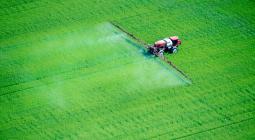Peel those apples: washing produce doesn’t remove pesticides, study finds

A new scientific report lends weight to consumer concerns about pesticide residues on food, presenting fresh evidence that washing fruit before eating does not remove various toxic chemicals commonly used in agriculture.
The paper, published on Wednesday in the American Chemical Society’s journal Nano Letters, comes amid ongoing debate over the extent of pesticide contamination of food, and the potential health risks associated with a steady diet that includes pesticide residues.
In May, Consumer Reports said it had determined that 20% of 59 different fruit and vegetable categories carried pesticide residues at levels that posed “significant risks” to consumers, based on an analysis of data gathered by the US Department of Agriculture (USDA).
The central aim of the new paper is to share the technical details of a process the authors developed for enhanced trace detection of pesticides in foods. But the underlying finding about the ineffectiveness of washing fruit is important for consumers who may be relying on food safety practices that are insufficient, the authors said.
Traditional “fruit-cleaning operations cannot wholly remove pesticides”, the paper states.
When using the technique to examine an apple, for instance, the researchers said the “imaging results prove that the pesticides penetrate the peel layer into the pulp layer”.
Using the technology they developed, the authors said they found the pesticide contamination diminished when the apple peel was removed along with some of the pulp layer.
“This study, situated within the expansive realm of food safety, endeavors to furnish health guidance to consumers,” said Dongdong Ye, a professor with China’s School of Materials and Chemistry at Anhui Agricultural University and an author of the paper. “Rather than fostering undue apprehension, the research posits that peeling can effectively eliminate nearly all pesticide residues, contrasted with the frequently recommended practice of washing.”
Consumer Reports senior scientist Michael Hansen said the new technique could be helpful to academics and government scientists in better understanding pesticide persistence in foods and how to better protect consumers.
“This is actually useful for understanding how these pesticides move in,” Hansen said. “This is more science showing that, yes, there are concerns. Don’t just think that washing is going to help you.”
The health risks posed by pesticides have been documented in several studies, but most of those deal with occupational exposure, rather than dietary. The USDAand the Food and Drug Administration maintain that pesticide residues in foods are not generally a concern for health if they fall within legal limits.
Both agencies have been tracking levels of pesticide residues in foods for decades, reporting their findings annually.
In the most recent USDA pesticide data program report, the agency said that 99% of foods tested had residues that fell within legal limits and thus did not “pose risk to consumers’ health and are safe”. This differs from the findings by Consumer Reports, which considers the limits used by the government to be too high.
More than 72% of the over 10,000 food samples carried detectable pesticide residues, the USDA reported.





